Intel Details Manufacturing through 2023: 7nm, 7+, 7++, with Next Gen Packaging
by Ian Cutress & Anton Shilov on May 8, 2019 4:35 PM ESTAt Intel's Investor Day today, CEO Bob Swan and Murthy Renduchintala spoke to the ability of the company with respect to its manufacturing capabilities. Intel has historically been strong in its ability to execute on its process technology, however the delay of its 10nm process has obviously raised multiple question marks, and has done for several years. The two Intel executives went into a little detail about what Intel was doing in the interim, and how it has learned from the issues.
Back in 2013, Intel envisoned its 10nm to succeed the 14nm by providing 2.7x density, with new technologies such as Self-Aligned Quad Patterning (SAQP), Contact over Active Gate (COAG), Cobolt Interconnects, and new packaging technologies such as EMIB and Foveros. Intel admits that this was an ambitious plan, and the goals were not clearly defined with the teams and it was ultimately overly complex and not managed in an ideal way.
This ended up pushing 10nm out into a later time frame. In this case, Intel pushed 10nm out to 2019 (technically they shipped Cannon Lake in small quantities on 10nm in 2017, however that is nothing more than a curio in the timeline of semiconductors), and filled the gap with 14+ and 14++.
Intels 14+ and 14++ processes extracted more than 20% more performance (from Broadwell to Whiskey Lake) from the process since its inception. As a result, Intel is prepared to not only get ready for future intra-node optimizations, but actually adjust the roadmap to compensate for it. Murthy made it clear that Intel wants to introduce a Moore's Law-like gain at the beginning of a new process, and another similar gain by the end of the process.
Intel has stated that its 10nm product family (beyond Cannon Lake) will start to be available from the middle of this year (2019), with Ice Lake on client platforms (notebooks).
Intel will be launching multiple 10nm products through 2019 and 2020, including server based 10nm in the first half of 2020:
In the above slide, Intel states that it will have 7nm in production and launching a product in 2021. That sounds very aggressive for a company that has had issues with 10nm. It even shows in Intels radmap, with 10nm (and 10+ and 10++) having a much shorter life cycle than the 14nm family of processes.
With this in mind, Intel's 7nm is going to be the combination of what Intel has learned from the 14nm and 10nm family of products. Intel wants that 2x scaling (Moores Law), but with intra-node optimations planned as part of the roadmap. Intel is also reducing its number of design rules, which should help with execution. 7nm will also be where Intel intersects with EUV, and also introduce next-gen Foveros and EMIB packainging.
Intel provided this slide, which shows a monolithic PC-Centric die with a multi-die Data-Centric chip built on both Foveros and EMIB. This corroborates our discussion with Intel's chiplet and packaging team, who also stated that we would see Foveros and EMIB on a combined product - specifically the GPU.
Intel announced that its lead 7nm product (lead = top, or lead = first?) would be its new GPGPU, built on the Xe graphics architecture. Intel has stated that its Xe product stack will feature two different microarchitectures from mobile client up to GPGPU, with one of those architectures called Arctic Sound - technically Intel will launch its first discrete GPU in 2020 according to its press release, however the 7nm GPGPU will be launched in 2021.
More information is coming out of Intel's Event, more to follow.
Related Reading
- Intel: EUV-Enabled 7nm Process Tech is on Track
- Intel Starts Qualification of Ice Lake CPUs, Raises 10nm Volume Expectation for 2019
- Intel Agilex: 10nm FPGAs with PCIe 5.0, DDR5, and CXL
- Intel to Equip Fab 42 for 7 nm
- Intel Discloses Plans to Spend $5 Billion on Fab 28 Expansion in Israel
- Intel Submits Ireland Fab Expansion Plan: $8 Billion Price Tag, With a 4 Year Lead Time
- Intel Details Plans for Its Oregon Fab Expansion: D1X Phase 3
- Intel to Expand Production Capacities at Multiple Fabs
Source: Intel


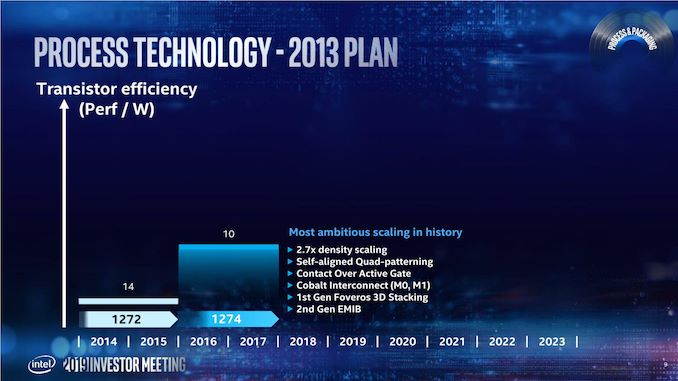

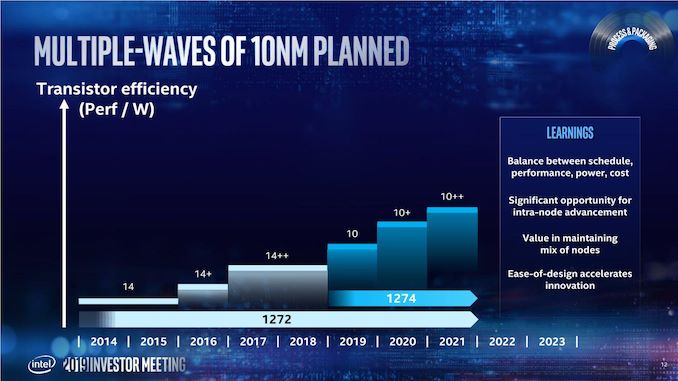
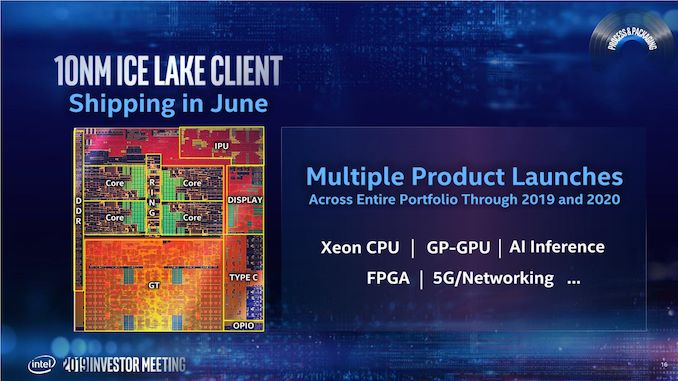
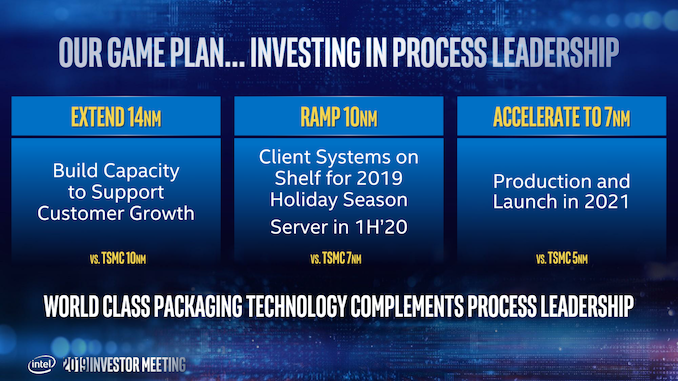
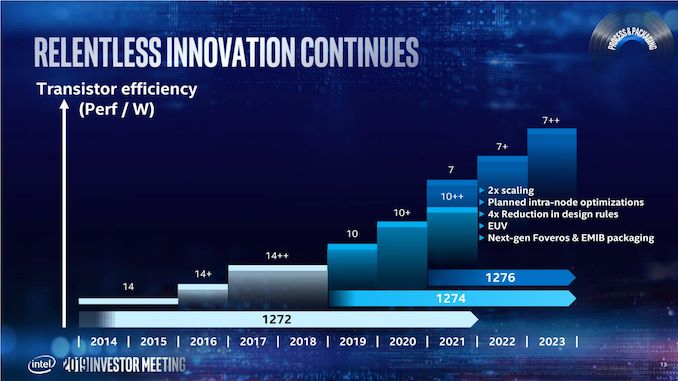










237 Comments
View All Comments
Notmyusualid - Friday, May 10, 2019 - link
@ Irata - Ha! I'm *almost* happy you said that!Sir, I have no need to lie to you.
Quote: "...fire resistant, liquid-crystal polymer fan is built with 0.2mm blades, sleeve bearings and 3-phase fan control to create less friction and circulate air more efficiently. The Area-51m fans occupy an area of 95x105mm with a thickness ranging from 19mm to 21.5mm and can push over 25 CFM in open air conditions—something normally seen only in desktops." https://www.dell.com/en-us/shop/cty/pdp/spd/alienw...
IF, this performance seems unusual to you, then it seems for once, I won the 'silicon lottery'.
Finally, my SPECview13 results from last night (for 1080 resoultion):
3dsmax-06 162.8
catia-05 111.72
creo-02 181.04
energy-02 20.46
maya-05 260.01
medical-02 53.04
showcase-02 107.57
snx-03 15.69
sw-04 84.09
Not bad for a laptop, AND only RTX2070M, not 2080 - didn't need it, just needed more CPU in this purchase.
Finally - as for power, 1x 330W & 1x 280W PSUs are required. Not convienent, I would agree.
Korguz - Friday, May 10, 2019 - link
post screen shots of all this.. as typing them.. you could type anything... also.. a screen of CPUZ would prove it...Notmyusualid - Saturday, May 11, 2019 - link
@ Korguz - no idea how to post a screenshot in this awful forum format, but I can give you this CPU-Z window taken just now:https://valid.x86.fr/7vbwpj
Targon - Friday, May 10, 2019 - link
Look at the timeline: Ryzen 7 first showed up in March of 2017, and even with immature OS support, Ryzen 7 beat the 7700k(the top end consumer chip at the time) in six out of eight areas. It took until 2018 with the release of the 9900k for Intel to actually regain a full leadership position in terms of performance.With Ryzen third generation being officially unveiled on May 27th, with specs and release dates, the dominance of the 9900k is expected to end. Exact performance in the real world, where independent benchmarks and tests can be performed will follow that release, but then, Intel isn't expected to regain ANY superiority on the desktop for at least two to three years.
Intel will still have the best laptop chip through 2019 due to AMD not having 7nm laptop chips set for this year, but then, once AMD has 7nm laptop chips out, will Intel have any area of superiority?
DannyH246 - Wednesday, May 8, 2019 - link
Yawn....nothing to see here. Just hot air and marketing crap.It’s so funny!!! Intel now seem to release a new “innovation” presentation every month. Lol
They will say anything to try and take attention from AMD. They look and sound desperate.
Sad.
imaheadcase - Wednesday, May 8, 2019 - link
You mean a roadmap that is normal? Or do you mean roadmaps that AMD failed to follow as well?Targon - Friday, May 10, 2019 - link
Intel is behind by four years for 10nm, so it makes sense to doubt any Intel roadmap until we see Intel being fairly close to being able to release products CLOSE to when they were expected. A schedule that slips by 3-4 months is fairly normal when it comes to engineering of new products, a schedule that slips by 3-4 years is fairly horrendous. Btw, over the years when 10nm just wasn't showing up, where were the improvements to IPC that shows that the core design was actually being worked on?Tkan215 - Wednesday, May 8, 2019 - link
Intel still believe they can decept. Amd will be aggressively like they mention. Thry know intel will come back since zen 1HStewart - Wednesday, May 8, 2019 - link
Article mentions 10nm shipping in June. Not to far a way to find outXyler94 - Thursday, May 9, 2019 - link
In what flavour though?A slow laptop CPU or high-performance Core i7/i9?